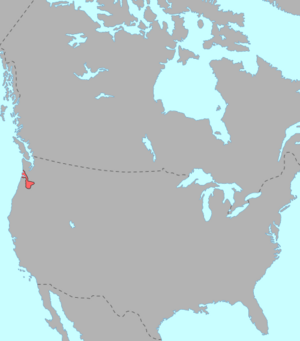Chinookan languages facts for kids
Quick facts for kids Chinook |
|
|---|---|
| Tsinúk | |
| Ethnicity: | Chinook |
| Geographic distribution: |
Columbia River Valley |
| Linguistic classification: | Penutian ?
|
| Subdivisions: |
Kiksht (Upper Chinook)
|
 Pre-contact distribution of Chinookan languages
|
|
The Chinookan languages were a small family of languages. They were spoken in Oregon and Washington. These languages were used by the Chinook people along the Columbia River. The last known native speaker of any Chinookan language died in 2012. However, a survey from 2009-2013 found 270 people. They said they spoke Upper Chinook.
Contents
What are the Chinookan Languages?
The Chinookan language family had three main languages. Each language also had different ways of speaking it. Experts sometimes disagree on how to group them.
- Lower Chinook (also called Chinook-proper or Coastal Chinook) †
- Kathlamet (also called Katlamat, Cathlamet) †
- Upper Chinook (also called Kiksht, Columbia Chinook) †
The names "Upper Chinook" and "Lower Chinook" refer to where they were spoken. Upper Chinook was spoken in the upper part of the Columbia River. Lower Chinook was spoken in the lower part of the Columbia River.
How Chinookan Words Were Built
Chinookan languages had a special way of building words. Verbs, which are action words, could often be a whole sentence by themselves. Nouns, which are naming words, could be added. But they mostly just gave more details to the verbs.
Words were put together in a specific order. The most important new information came first. Clauses, which are parts of a sentence, were joined by putting them next to each other. They could also be joined with small connecting words.
Verb Structure
Chinookan verbs were very complex. They had many small parts added to them. These parts could show when something happened, like in the past or future. They also showed who was doing the action.
For example, the Kiksht language had six ways to show time. These included a "mythic past" for old stories. There was also a "remote past" for long ago events. Other times included recent past, immediate past, present, and future.
These small parts added to verbs were very important. They showed who was acting. They also showed who was affected by the action. Some parts could even show if the action was done to oneself.
Noun Structure
Nouns also had small parts added to them. These parts could show if something was a person or an object. They could also show if it was male or female. For example, bigger animals might use "male" parts. Smaller animals might use "female" parts.
Understanding Gender and Number
In Chinookan languages, words changed based on gender and number. This means if something was male, female, or neutral. It also changed if there was one of something, two, or many.
These changes often happened at the beginning of a word. They also showed who owned something. For example, there were different ways to say "her" depending on the noun. There were also different ways to say "my."
The way a word changed also depended on its role in the sentence. For example, the way a verb showed its subject could be different. This depended on if the verb was about an action done to someone.
The Chinook Jargon
The original Chinook Jargon was a simpler language. It was first used by different Native American groups. They used it to talk to each other for trade. It was like a common language.
This jargon was different from Chinookan languages. It did not have complex word structures. It also put words in a different order. For example, Chinookan languages often put the verb first. But Chinook Jargon put the subject first.
Later, the Chinook Jargon gained many words from English and French. It became very popular. Up to 100,000 people used it in the 1800s. These people spoke about 100 different native languages.
The Decline of Chinookan Languages
Chinook-speaking groups were powerful traders long ago. This was before and during the first European contacts. The Lewis & Clark explorers met them. This is why the Chinook Jargon developed.
Sadly, European diseases greatly reduced the Chinook population. In 1800, there were about 800 Chinook people. Many mixed with other groups. By 1900, most Chinookan languages were no longer spoken.
The last fully fluent speaker of Wasco-Wishram, Gladys Thompson, died in 2012. This meant the language family became extinct.
The Chinook people were officially recognized by the U.S. government in 2001. However, another tribe appealed this decision.
See also
 In Spanish: Lenguas chinukanas para niños
In Spanish: Lenguas chinukanas para niños

